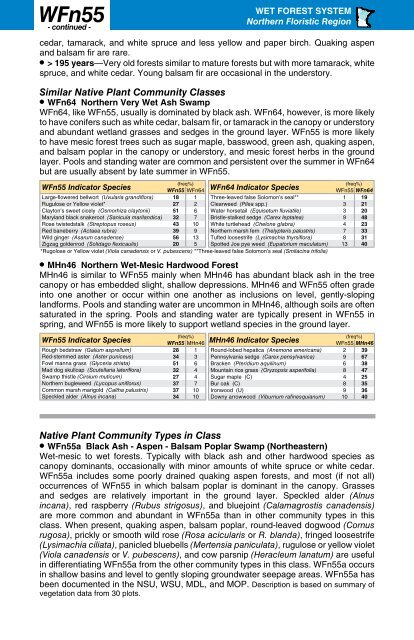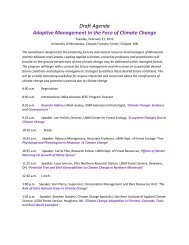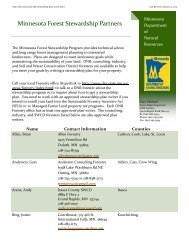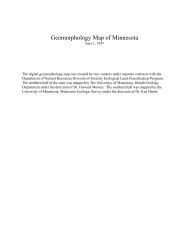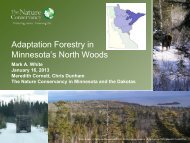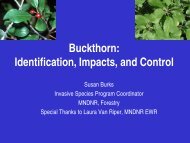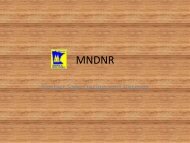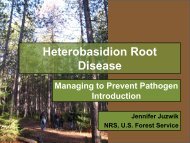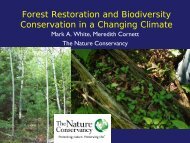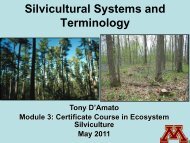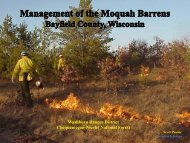WFn55 Northern Wet Ash Swamp factsheet
WFn55 Northern Wet Ash Swamp factsheet
WFn55 Northern Wet Ash Swamp factsheet
Create successful ePaper yourself
Turn your PDF publications into a flip-book with our unique Google optimized e-Paper software.
<strong>WFn55</strong><br />
- continued -<br />
cedar, tamarack, and white spruce and less yellow and paper birch. Quaking aspen<br />
and balsam fir are rare.<br />
• > 195 years—Very old forests similar to mature forests but with more tamarack, white<br />
spruce, and white cedar. Young balsam fir are occasional in the understory.<br />
Similar Native Plant Community Classes<br />
• WFn64 <strong>Northern</strong> Very <strong>Wet</strong> <strong>Ash</strong> <strong>Swamp</strong><br />
WFn64, like <strong>WFn55</strong>, usually is dominated by black ash. WFn64, however, is more likely<br />
to have conifers such as white cedar, balsam fir, or tamarack in the canopy or understory<br />
and abundant wetland grasses and sedges in the ground layer. <strong>WFn55</strong> is more likely<br />
to have mesic forest trees such as sugar maple, basswood, green ash, quaking aspen,<br />
and balsam poplar in the canopy or understory, and mesic forest herbs in the ground<br />
layer. Pools and standing water are common and persistent over the summer in WFn64<br />
but are usually absent by late summer in <strong>WFn55</strong>.<br />
<strong>WFn55</strong> Indicator Species<br />
(freq%)<br />
<strong>WFn55</strong> WFn64<br />
Large-flowered bellwort (Uvularia grandiflora) 18 1<br />
Rugulose or Yellow violet* 27 2<br />
Clayton’s sweet cicely (Osmorhiza claytonii) 51 6<br />
Maryland black snakeroot (Sanicula marilandica) 32 7<br />
Rose twistedstalk (Streptopus roseus) 43 10<br />
Red baneberry (Actaea rubra) 39 9<br />
Wild ginger (Asarum canadense) 56 13<br />
Zigzag goldenrod (Solidago flexicaulis) 20 5<br />
WET FOREST SYSTEM<br />
<strong>Northern</strong> Floristic Region<br />
WFn64 Indicator Species<br />
(freq%)<br />
<strong>WFn55</strong> WFn64<br />
Three-leaved false Solomon’s seal** 1 19<br />
Clearweed (Pilea spp.) 3 21<br />
Water horsetail (Equisetum fluviatile) 3 20<br />
Bristle-stalked sedge (Carex leptalea) 9 48<br />
White turtlehead (Chelone glabra) 4 23<br />
<strong>Northern</strong> marsh fern (Thelypteris palustris) 7 33<br />
Tufted loosestrife (Lysimachia thyrsiflora) 8 31<br />
Spotted Joe pye weed (Eupatorium maculatum) 13 40<br />
*Rugolose or Yellow violet (Viola canadensis or V. pubescens) **Three-leaved false Solomon’s seal (Smilacina trifolia)<br />
• MHn46 <strong>Northern</strong> <strong>Wet</strong>-Mesic Hardwood Forest<br />
MHn46 is similar to <strong>WFn55</strong> mainly when MHn46 has abundant black ash in the tree<br />
canopy or has embedded slight, shallow depressions. MHn46 and <strong>WFn55</strong> often grade<br />
into one another or occur within one another as inclusions on level, gently-sloping<br />
landforms. Pools and standing water are uncommon in MHn46, although soils are often<br />
saturated in the spring. Pools and standing water are typically present in <strong>WFn55</strong> in<br />
spring, and <strong>WFn55</strong> is more likely to support wetland species in the ground layer.<br />
<strong>WFn55</strong> Indicator Species<br />
(freq%)<br />
<strong>WFn55</strong> MHn46<br />
Rough bedstraw (Galium asprellum) 28 1<br />
Red-stemmed aster (Aster puniceus) 34 3<br />
Fowl manna grass (Glyceria striata) 51 6<br />
Mad dog skullcap (Scutellaria lateriflora) 32 4<br />
<strong>Swamp</strong> thistle (Cirsium muticum) 27 4<br />
<strong>Northern</strong> bugleweed (Lycopus uniflorus) 37 7<br />
Common marsh marigold (Caltha palustris) 37 10<br />
Speckled alder (Alnus incana) 34 10<br />
MHn46 Indicator Species<br />
(freq%)<br />
<strong>WFn55</strong> MHn46<br />
Round-lobed hepatica (Anemone americana) 2 39<br />
Pennsylvania sedge (Carex pensylvanica) 9 67<br />
Bracken (Pteridium aquilinum) 6 38<br />
Mountain rice grass (Oryzopsis asperifolia) 8 47<br />
Sugar maple (C) 4 25<br />
Bur oak (C) 8 35<br />
Ironwood (U) 9 36<br />
Downy arrowwood (Viburnum rafinesquianum) 10 40<br />
Native Plant Community Types in Class<br />
• <strong>WFn55</strong>a Black <strong>Ash</strong> - Aspen - Balsam Poplar <strong>Swamp</strong> (Northeastern)<br />
<strong>Wet</strong>-mesic to wet forests. Typically with black ash and other hardwood species as<br />
canopy dominants, occasionally with minor amounts of white spruce or white cedar.<br />
<strong>WFn55</strong>a includes some poorly drained quaking aspen forests, and most (if not all)<br />
occurrences of <strong>WFn55</strong> in which balsam poplar is dominant in the canopy. Grasses<br />
and sedges are relatively important in the ground layer. Speckled alder (Alnus<br />
incana), red raspberry (Rubus strigosus), and bluejoint (Calamagrostis canadensis)<br />
are more common and abundant in <strong>WFn55</strong>a than in other community types in this<br />
class. When present, quaking aspen, balsam poplar, round-leaved dogwood (Cornus<br />
rugosa), prickly or smooth wild rose (Rosa acicularis or R. blanda), fringed loosestrife<br />
(Lysimachia ciliata), panicled bluebells (Mertensia paniculata), rugulose or yellow violet<br />
(Viola canadensis or V. pubescens), and cow parsnip (Heracleum lanatum) are useful<br />
in differentiating <strong>WFn55</strong>a from the other community types in this class. <strong>WFn55</strong>a occurs<br />
in shallow basins and level to gently sloping groundwater seepage areas. <strong>WFn55</strong>a has<br />
been documented in the NSU, WSU, MDL, and MOP. Description is based on summary of<br />
vegetation data from 30 plots.<br />
162


